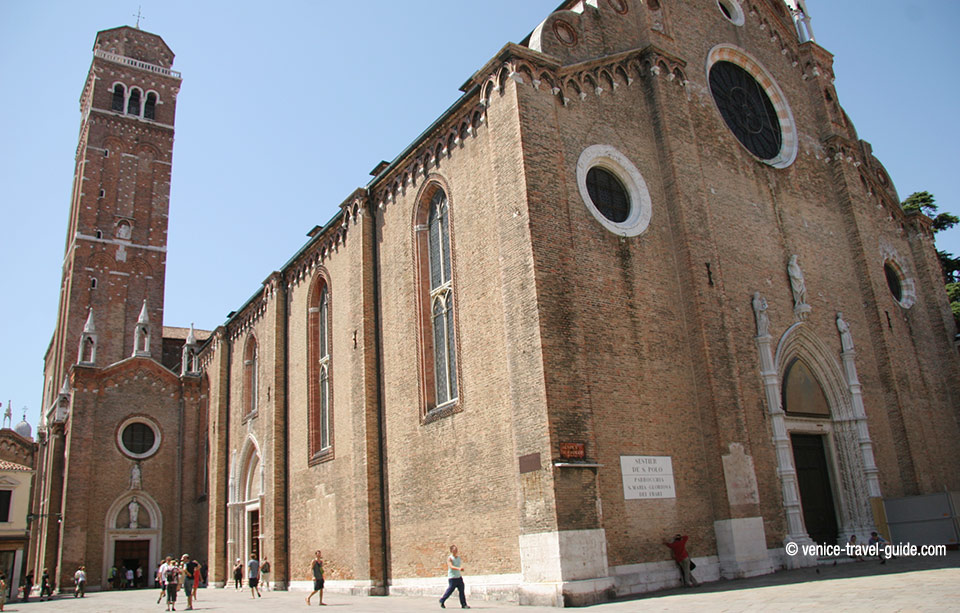The Basilica di Santa Maria Gloriosa dei Frari, usually just called the Frari, is one of the main churches in Venice. The imposing brick edifice is built in Italian Gothic style. The bell tower, finished in 1396, is one of the highest in the city. The church has many Renaissance masterpieces.
The church has so many Renaissance masterpieces that it is rightly felt to be one of the most import Renaissance museums in the city. Some of them are the Titian's The Assumption and the Pesaro altar-piece by Titan, the Madonna and Saints by Giovanni Bellini, the St John the Baptist by Donatello and the Monument to Canova.
The Franciscan friars (or Frari) arrived in Venice in 1222 and lived on charily. They had no permanent home until 1250, when Doge Jacopo Tiepolo gave them some land on which to build a church. This church, much smaller than the current one and facing the opposite direction, was reconstructed in the mid-14th century in the Gothic style, earning itself the nickname of Ca' Granda (the big house). The imposing brick facade, eschewing expensive materials, is in stark contrast with the sobriety of the Dominican church of San Zanipolo, built at the same time. The facade, with its huge central rosette and tripartite structure defined by pilaster strips, is adorned with small niches.
The bell tower, finished in 1396 according to a stone inscription, is one of the highest in Venice. The church's Latin cross form was given a striking transept that opens up into the presbytery, which in turn is flanked by three lateral chapels. The sacristy and the Corner chapel were added in the Renaissance. Large pillars are joined by a wooden chain, hold up the large ogival arches and separate the three naves which are closed off by cruciform vaults. The High Gothic wooden choir was built in 1468, and is divided into three orders with 124 seals. It is contained within and delimits the large nave (decorated by Bartolomeo Bon). The church has so many Renaissance masterpieces that it is rightly felt to be one of the most import Renaissance museums in the city.
The Assunta {Assumption) altar-piece, concluded by Titian in 1518, towers over the main altar and dominates the entire church with its chromatic and dynamic power. The painting's emotional charge derives from the fact that the scene seems to be taking place as we are observing it. The Pesaro altar-piece (1519-1526), an overwhelming portrait of the Pesaro family, represents Titian's break with the central representational scheme. In this painting he places the Virgin Mary's throne along a diagonal axis, and uses three distinct figurative groups to break up the work's spatial structure.
The Madonna and Saints altar-piece, painted by Giovanni Bellini in 1488 for the sacristy altar, is a mature work playing on the theme indicated by the title. Here the figures are psychologically humanised, placed within a devotional atmosphere where they seem to he transported by the music of the surrounding instruments and the vibrant light that fills the surrounding space.
The arrival of Donatello's wooden statue of St John the Baptist, originally intended for a merchants' chapel in Florence, in 1438 led to a great renewal that influenced entire generations of artists. The saint's expressive force, his disconcerting thinness accentuated by the short tunic, is one of the most realistic examples in the history of sculpture.
One of the church's main funeral monuments is the Monument to Doge Tron (1477-1479), Antonio Rizzo's first real masterpiece. In the work the Doge is accompanied by a series of seductive Virtues.
The Monument to Canova, however, an imposing Neoclassical pyramidal structure, was sculpted by Canova's students Luigi and Pietro Zandomenighi in l827, and the small porphyry vase contains the heart of the artist, who died in1822. The original project was Canova's but he had intended it as a monument to Titian, who while dying of the plague in 1576, asked to be buried in the Frari. The Monument to Canova was erected in front of The Titian Mausoleum (1835-1852).
Works of art
See: Basilica dei Frari Artworks
- Giovanni Bellini, Madonna and Child with SS Nicholas of Bari, Peter, Mark and Benedict, the sacristy altarpiece
- Bartolomeo Bon's workshop, figures of the Virgin and St Francis on the west front
- Antonio and Paolo Bregno, tomb of Doge Francesco Foscari in the chancel (attributed; may actually be by Niccolò di Giovanni Fiorentino)
- Lorenzo Bregno: tomb of Benedetto Pésaro above the sacristy door
- Lorenzo Bregno: tomb of Alvise Pasqualino on the west wall
- Girolamo Campagna, statuettes of St Anthony of Padua and St Agnes on the water stoups in the nave
- Marco Cozzi, choir stalls in ritual choir
- Donatello, figure of St John the Baptist in the first south choir chapel, Donatello's first documented work in Venice
- Tullio Lombardo, tomb of Pietro Bernardo on the west wall (attributed; may actually be by Giovanni Buora)
- Antonio Rizzo, tomb of Doge Niccolò Tron in the chancel
- Jacopo Sansovino, damaged figure of St John the Baptist on the font in the Corner Chapel
- Titian: Assumption, the altarpiece of the high altar and the largest altarpiece in Venice
- Titian: Pesaro Madonna on the north wall of the nave
- Paolo Veneziano, Doge Francesco Dandolo and His Wife Presented to the Virgin by SS Francis and Elizabeth in the sacristy
- Alessandro Vittoria: figure of The Risen Christ on the west front
- Alessandro Vittoria: figure of St Jerome on the south wall of the nave
- Alvise Vivarini, St Ambrose and other Saints in the north transept chapel, his last work
- Bartolomeo Vivarini: St. Mark Enthroned in the Capella Corner in the north transept
- Bartolomeo Vivarini: Madonna and Child with Saints, altarpiece in the third south choir chapel
Funerary monuments
- Francesco Barbaro (1390–1454) humanist and senator.
- Pietro Bernardo (d.1538) (senator)
- Antonio Canova (only his heart is buried here; the tomb, realised by his disciples, is based on the drawing of Canova himself for an unrealised tomb for Titian)
- Federico Corner
- Doge Francesco Dandolo (in the chapter house)
- Doge Francesco Foscari (d.1457)
- Tomb of General Jacopo Marcello
- Claudio Monteverdi one of the greatest composers of the 17th Century
- Beato Pacifico (founder of the current church)
- Alvise Pasqualino (d.1528) (Procurator of Venice)
- Benedetto Pésaro (d.1503) (general)
- Doge Giovanni Pesaro
- Bishop Jacopo Pésaro (d.1547)
- Paolo Savelli (condottiere), the first Venetian monument to include an equestrian statue.
- Titian (d. 1576)
- Melchiorre Trevisan (d.1500), general.
- Doge Niccolò Tron
Map of Frari Church




